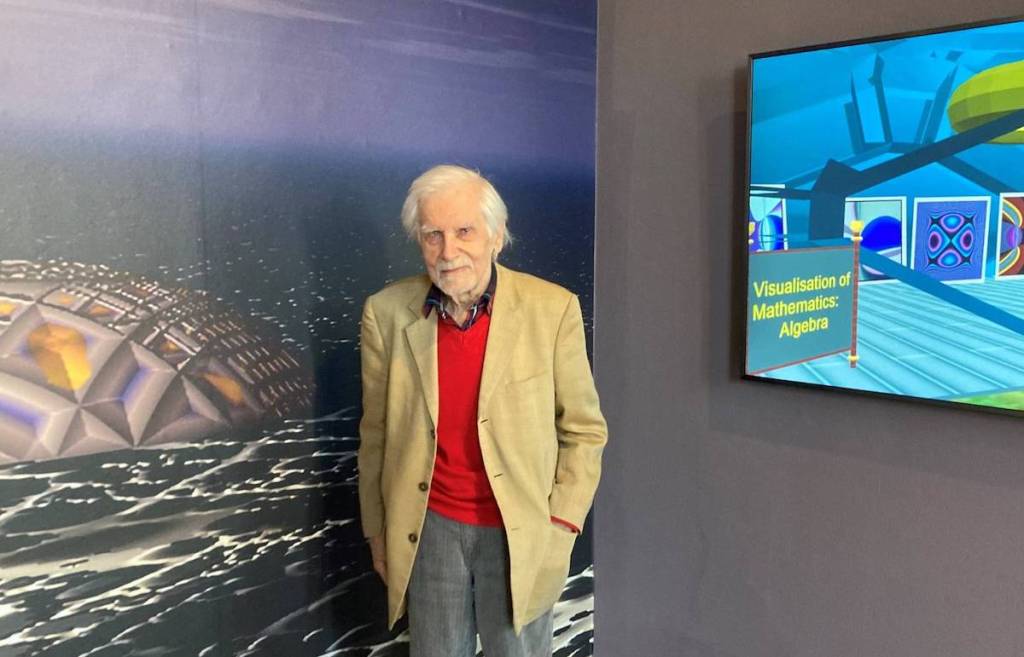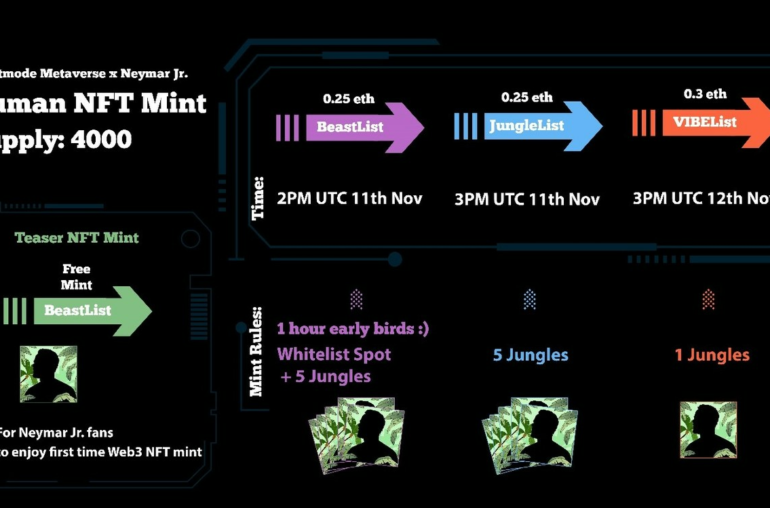By Reena Devi
The 95-year-old Austrian artist Herbert W. Franke, who uses algorithms and computer programs to visualize math as art, has recently become a sensation within the art world—and the crypto space.
Earlier this month, the physicist and science fiction writer was behind one of the most talked about digital artworks at a booth by the blockchain company Tezos at Art Basel. Titled MONDRIAN (1979), the work paid tribute to artist Piet Mondrian’s iconic geometric visuals using a program written on one of the first home computers. By scanning the QR code, users could see the work and mint editions of it for free.
blogherads
.defineSlot( ‘medrec’, ‘gpt-dsk-tab-mid-article1-uid0’ )
.setTargeting( ‘pos’, [“mid-article1″,”mid”,”mid-article”,”mid-articleX”] )
.setSubAdUnitPath(“ros/mid-article”)
.addSize([[2,2],[300,250],[300,251]])
;
});
Days before this, Franke, who studied physics in Vienna following World War II and started working at Siemens in 1953, where he conducted photographic experiments after office hours, launched 100 images from his famed series “Math Art” (1980–95) as NFTs on the Quantum platform. The drop was meant to commemorate his birthday on May 14 and to raise funds for his foundation. The NFTs sold out in 30 seconds, with the likes of pioneering blockchain artist Kevin Abosch purchasing a few.
And earlier this year at the Francisco Carolinum in Linz, Austria, there was a survey of Franke’s artworks spanning across decades. In tandem with the show, parts of Franke’s photo archive will be made available. Additionally, a new English translation of his quintessential publication Art and Construction (1957) will be released later this year.
To find out more about Franke’s late-career resurgence, ARTnews spoke with the multihyphenate artist over a series of emails.
This conversation has been edited for clarity and length.
ARTnews: You’re involved in a quite a number of collaborations and exhibitions in 2022. Most recently, the Tezos Foundation at Art Basel featured your work MONDRIAN (1979). The Francisco Carolinum in Linz, Austria, also held a solo show this year, “Herbert W. Franke: Visionary.” Could you tell us a bit more about both exhibitions?
Herbert W. Franke: MONDRIAN is the name of a dynamic program for images and sound that I developed for Texas Instruments 99/4 in 1979. It is named after the Dutch artist and follows his characteristic principles of horizontal versus vertical. It could be used in two ways. First, it permits the selective construction of individual images, in a kind of step-by-step operation in which the user can interactively change parameters like colors or strip thickness at any time. Secondly, it was also possible to design a dynamic sequence that changes constantly, controlled by algorithms and random processes. In the endless-automatic operating mode, the program also algorithmically generated sound effects related to the image structures.
The video shown at the booth of Tezos was a film that was produced in 2010 for my solo exhibition at the ZKM Center for Art and Media Karlsruhe in Germany. A video camera filmed the monitor connected to my historic TI 99/4A that I had donated to the ZKM like other early computers of mine. As the Tezos booth had this big screen, we thought a moving film like MONDRIAN could be a nice historic work for that purpose. The only restriction was that we did not want to sell it.
As for the Francisco Carolinum exhibition, I was not involved too much personally. As I mentioned, my wife Susanne had taken over all works related to my art since many years. She has also operated a website, www.art-meets-science.io, since 2007 that honors my work. She is an expert in understanding my thoughts, and the Francisco Carolinum asked her to be one of the curators together with curator Genoveva Rueckert from the museum. But you can imagine that Susanne informed me about her concepts and thoughts, and we talked internally about how to present my work.
You also did an NFT drop earlier this year. Was this your first time? Why do you choose to work with NFTs despite the volatility and divisiveness of this nascent technology?
We have done only one big drop so far on May 31, my 95th birthday edition of 100 images of my “Math Art” series. Before, there was a test selling of three or four images to better understand the technology. And yes, you are right, volatility and divisiveness are appropriate descriptions, but this was never a problem for me as an artist, as you know. Blockchain is a totally new environment, and this technology is still in its early stages, like at the beginning of computer art. But I am convinced that it has opened a new door for digital art and introduced the next generation to this new technology.
During an interview with Right Click Save in April, you talked about how in the NFT world, “computer art has now entered the traditional art world along with a lot of money and therefore a mighty roar. However, this does not mean that it is mainstream yet. Artists working with code today are still struggling for recognition in the same way that we did back in the 1960s.” Why do you think this kind of art is not mainstream yet?
I believe that it is the same problem as 60 or 70 years ago. Most people, as well as most art historians, still believe technology and visual art do not fit together. I always argue that one should look to music where high-tech precision machines have been used to produce art for centuries. Nobody feels strange about this because instruments have a long tradition. But most visual artists in the 21st century are still focused on traditional techniques.
Despite this, you have become a bit of a Twitter sensation of late, with close to 15,000 followers since you joined the platform a few months ago. Could you share how this happened? Also, has joining Twitter spurred further interest in your work as a media art pioneer who explored the code of the visual since the 50s?
We opened a Twitter account in March because Austrian art historian and former museum director Alfred Weidinger and German art critic and curator Anika Meier told us we should do this and that my work has reputation in the scene. We were not sure about this. But having 10,000 followers in two days made clear that there is a community that knows my work. Many young artists in the field related to crypto and the metaverse tweeted that they were influenced by my work.
Up until now, my wife Susanne took care of marketing and sales as a part-time job, but that is not her core competence, as she is a journalist and a media expert. After this overwhelming acceptance in the Twitter world, she told me that we need to “professionalize” this field to move forward in this path, and we began to explore options (such as exhibitions and partnerships) to bring my achievements to a broader public. In doing so, we have received quite a bit of interest to enrich various programs with my pioneering work.
On a more personal note, given that you turned 95 years old this year, could you share what you would consider a major turning point in your trajectory as a digital artist and writer? Is there anything you wish you could have changed?
I think my way was rather a steady path and there were no direct turning points. However, I may mention the talks with my mentor German historian of modern art, Franz Roh. He told me that I should not look at my works as a hobby but do this work seriously, as it could arise to something relevant in art. This was back in the ’50s at the very beginning when I wanted to publish my first book about art titled Art and Construction – Mathematics and Physics as a photographic experiment. I found no editor for publication.
At the same time, Roh was working on an art book that would be published by Bruckmann Edition. Roh told Friedrich Bruckmann, the art historian and well-known publisher in Germany, that he wanted to step back to open the door for my manuscript to be published because he thought these ideas were important. So I got the attention that a young artist needs to be published. I should also mention that Roh’s book was published then as well. I am not sure whether it was a turning point, but it helped me to find my way and keep me on track. I think having a mentor like Franz Roh is very important to pave the way for a young artist.
There is really nothing important I would like to change. However, when you are working as a freelancer, you have to use part of your time to earn money. Sometimes the work is nice, but mostly it is time that you could have spent better with own projects. So maybe I would have liked to have been born in a rich family where I could work 100 percent on my own ideas and projects.
What are your thoughts on the ongoing digital disruption, via NFTs, metaverse, virtual reality and other related technologies, in the art world and beyond? How do you think your work contributed to these developments, as the “Father of Computer Art”?
Looking at it from the commercial aspects of crypto art, disruption impacting the traditional art world seems to be a new phenomenon. However, ultimately, disruption is nothing new at all. What is new is its public awareness. And that’s the point, because nowadays big money is involved in the crypto scene.
I would like to quote from the introduction to Art and Construction: “Technology is usually dismissed as an element hostile to art. I want to try to prove that it is not, that it even opens up unimagined new artistic territory for us.” I was convinced that we were at the beginning of new methods in art that would be dominated by automata and machines. I was sure that the work of the artist would move into analytical construction—in the digital world we call it coding now. The core of my early experiments was built with art forms of light, called generative art today, working with photo apparatus, X-ray machines, microscopes, and an analog computer for calculating these light waves.
In your opinion, how will digital arts transform in the next 10–50 years?
I always said that it is much easier to make forecasts about the future in hundreds of years and much more difficult to foresee 10 years ahead. But I am convinced: We are on our way to understanding the code of art. So I dare to make a prognosis: Music will evolve deeply towards automated composing in the next coming years. Other art forms like visual arts will follow later—literature at the end. It is the most complex art form to bring down to algorithms.
The World's Premier Art Magazine since 1913. Subscribe today and save up to 33%!
Sign Up for our Newsletters
Get our latest stories in the feed of your favorite networks
We want to hear from you! Send us a tip using our anonymous form.
Subscribe to our newsletters below
ARTnews is a part of Penske Media Corporation. © 2022 Art Media, LLC. All Rights Reserved.



